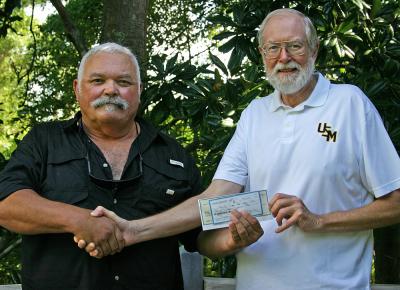HOSSFLY Partners with GCRLs Tarpon Project
Tue, 10/12/2010 - 01:57pm | By: Martha Duvall

Tom Herrington, founding member of the Historic Ocean Springs Saltwater Flyfishing Club (HOSSFLY), recently led a “fly-tying” auction to raise money in support of Gulf Coast Research Laboratory's (GCRL) tarpon research project.
“This donation, totaling $1,000 is of tremendous importance as we expand our field research efforts to describe the distribution and habitat preferences of young tarpon in Mississippi coastal waters,” said Jim Franks, GCRL fisheries biologist. “We are extremely grateful to have HOSSFLY as a partner in tarpon research.”
For the past four years, Franks and GCRL colleague Paul Grammer have been documenting the occurrence and distribution of the juvenile tarpon in local waters, specifically bayous and tidal sloughs.
“Tarpon is considered by most flyfishers as a premier sport fish in the Gulf of Mexico,” said Herrington. “HOSSFLY is proud to support this important, new research.”
Based on GCRL research, and anecdotal information, it appears that the abundance of juvenile tarpon in local waters has increased substantially in recent years. This is an indication that Mississippi coastal waters and marshlands may serve as a critical nursery habitat for young tarpon.
“We have collected numerous specimens of juvenile tarpon,” said Franks, “some as small as two inches in length. The majority of the young fish were tagged and released. A few local sport fishers have reported to us their catches of young tarpon weighing up to 15 pounds, and we've actually examined a few of those specimens.”
Franks encourages anyone who catches young tarpon, particularly a tagged tarpon, to report the catch by calling his lab at 228.872.4202. Additional funding for this research is provided through a grant from the Mississippi Department of Marine Resources.